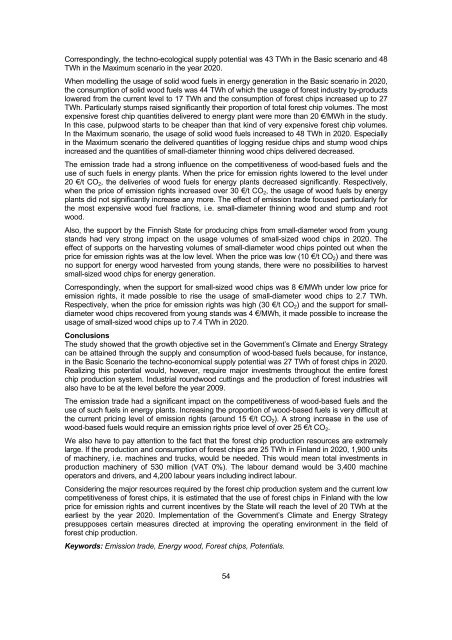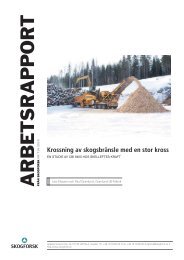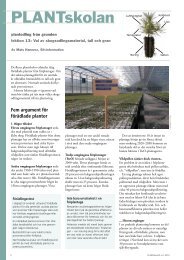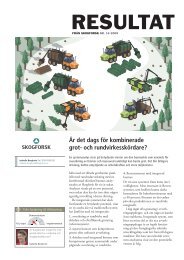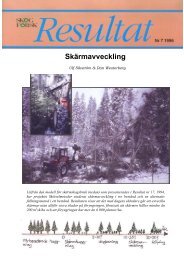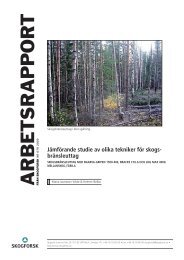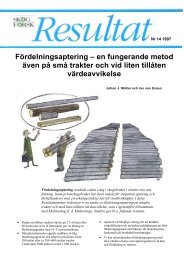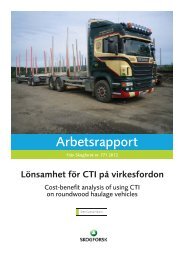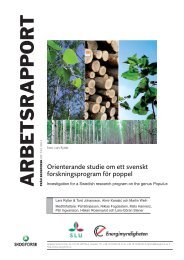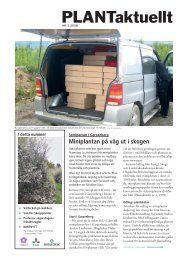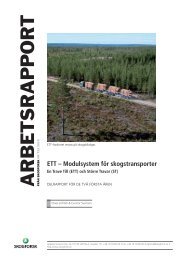Download pdf - Skog og landskap
Download pdf - Skog og landskap
Download pdf - Skog og landskap
You also want an ePaper? Increase the reach of your titles
YUMPU automatically turns print PDFs into web optimized ePapers that Google loves.
Correspondingly, the techno-ecol<strong>og</strong>ical supply potential was 43 TWh in the Basic scenario and 48<br />
TWh in the Maximum scenario in the year 2020.<br />
When modelling the usage of solid wood fuels in energy generation in the Basic scenario in 2020,<br />
the consumption of solid wood fuels was 44 TWh of which the usage of forest industry by-products<br />
lowered from the current level to 17 TWh and the consumption of forest chips increased up to 27<br />
TWh. Particularly stumps raised significantly their proportion of total forest chip volumes. The most<br />
expensive forest chip quantities delivered to energy plant were more than 20 €/MWh in the study.<br />
In this case, pulpwood starts to be cheaper than that kind of very expensive forest chip volumes.<br />
In the Maximum scenario, the usage of solid wood fuels increased to 48 TWh in 2020. Especially<br />
in the Maximum scenario the delivered quantities of l<strong>og</strong>ging residue chips and stump wood chips<br />
increased and the quantities of small-diameter thinning wood chips delivered decreased.<br />
The emission trade had a strong influence on the competitiveness of wood-based fuels and the<br />
use of such fuels in energy plants. When the price for emission rights lowered to the level under<br />
20 €/t CO 2 , the deliveries of wood fuels for energy plants decreased significantly. Respectively,<br />
when the price of emission rights increased over 30 €/t CO 2 , the usage of wood fuels by energy<br />
plants did not significantly increase any more. The effect of emission trade focused particularly for<br />
the most expensive wood fuel fractions, i.e. small-diameter thinning wood and stump and root<br />
wood.<br />
Also, the support by the Finnish State for producing chips from small-diameter wood from young<br />
stands had very strong impact on the usage volumes of small-sized wood chips in 2020. The<br />
effect of supports on the harvesting volumes of small-diameter wood chips pointed out when the<br />
price for emission rights was at the low level. When the price was low (10 €/t CO 2 ) and there was<br />
no support for energy wood harvested from young stands, there were no possibilities to harvest<br />
small-sized wood chips for energy generation.<br />
Correspondingly, when the support for small-sized wood chips was 8 €/MWh under low price for<br />
emission rights, it made possible to rise the usage of small-diameter wood chips to 2.7 TWh.<br />
Respectively, when the price for emission rights was high (30 €/t CO 2 ) and the support for smalldiameter<br />
wood chips recovered from young stands was 4 €/MWh, it made possible to increase the<br />
usage of small-sized wood chips up to 7.4 TWh in 2020.<br />
Conclusions<br />
The study showed that the growth objective set in the Government’s Climate and Energy Strategy<br />
can be attained through the supply and consumption of wood-based fuels because, for instance,<br />
in the Basic Scenario the techno-economical supply potential was 27 TWh of forest chips in 2020.<br />
Realizing this potential would, however, require major investments throughout the entire forest<br />
chip production system. Industrial roundwood cuttings and the production of forest industries will<br />
also have to be at the level before the year 2009.<br />
The emission trade had a significant impact on the competitiveness of wood-based fuels and the<br />
use of such fuels in energy plants. Increasing the proportion of wood-based fuels is very difficult at<br />
the current pricing level of emission rights (around 15 €/t CO 2 ). A strong increase in the use of<br />
wood-based fuels would require an emission rights price level of over 25 €/t CO 2 .<br />
We also have to pay attention to the fact that the forest chip production resources are extremely<br />
large. If the production and consumption of forest chips are 25 TWh in Finland in 2020, 1,900 units<br />
of machinery, i.e. machines and trucks, would be needed. This would mean total investments in<br />
production machinery of 530 million (VAT 0%). The labour demand would be 3,400 machine<br />
operators and drivers, and 4,200 labour years including indirect labour.<br />
Considering the major resources required by the forest chip production system and the current low<br />
competitiveness of forest chips, it is estimated that the use of forest chips in Finland with the low<br />
price for emission rights and current incentives by the State will reach the level of 20 TWh at the<br />
earliest by the year 2020. Implementation of the Government’s Climate and Energy Strategy<br />
presupposes certain measures directed at improving the operating environment in the field of<br />
forest chip production.<br />
Keywords: Emission trade, Energy wood, Forest chips, Potentials.<br />
54


